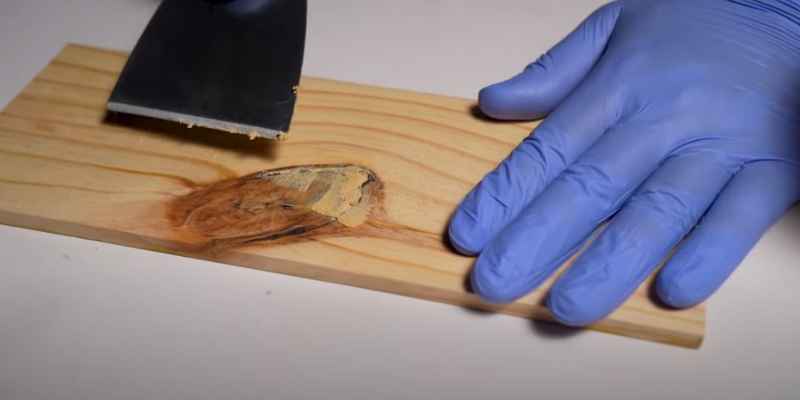To stain wood filler to match, you can use water-based dye or stain for water-based products and solvent-based dye or stain for solvent-based products, making sure not to dilute the product too much. You can also pre-color the wood filler with wood stain before application to blend it better with the wood finish.
It may be necessary to use a darker stain when tinting the filler to match colors. Additionally, you can darken the wood filler after staining by using products like General Finishes Water Based Wood Stain or General Finishes Dye Stain.
Overall, the key is to experiment and test different stains or dyes until you achieve the desired color match with the wood filler.
Coloring Wood Filler
Coloring wood filler to match the surrounding wood is crucial for a seamless finish. Whether you are repairing furniture or filling gaps in a hardwood floor, using the right technique can make all the difference in achieving a professional look.
Using Water-based Dye Or Stain
When it comes to coloring wood filler, you can use either water-based dye or stain for water-based products. Solvent-based products require a solvent-based dye or stain. It’s essential to choose the right type of coloring agent to ensure a perfect match.
Choosing The Right Product Concentration
It’s vital not to dilute the coloring product too much when blending it with wood filler. This ensures that the color intensity remains strong, allowing you to achieve the desired shade that matches the surrounding wood perfectly.
Matching Wood Filler To Stain
To match wood filler to a stain, dampen the area to be filled before applying the colored filler. Pre-color the filler with wood stain for a seamless blend with the wood finish. Choose a dye or stain that complements the existing wood color for best results.
How to Stain Wood Filler to Match
When it comes to woodworking projects, using wood filler is often necessary to fill in gaps and imperfections in the wood. However, the challenge arises when you need to match the color of the wood filler to the rest of the wood surface. In this blog post, we will explore techniques for matching wood filler to stain, so your project looks seamless and professional.
Darkening Wood Filler Post-Staining
After you have applied the wood filler and it has dried, you may find that the color doesn’t quite match the surrounding wood. Don’t worry! There are ways to darken the wood filler to achieve a better color match. One option is to use a wood stain. You can mix a small amount of wood stain into the wood filler, gradually adding more until you achieve the desired shade. Just be careful not to dilute the filler too much, as it may affect the structural integrity.
Another option is to use a dye stain specifically designed for wood. These stains are usually more concentrated and can be mixed with the wood filler to darken it effectively. Consider using products like General Finishes Water Based Wood Stain in Espresso or a dye stain color from General Finishes. If you’re working with oil-based putty, you can mix it with oil-based stains like General Finishes Gel Stain in Java.
Blending Filler with Wood
Blending the wood filler with the rest of the wood is essential to achieve a seamless finish. One technique used by expert woodworkers is to pre-color the wood filler before application. By mixing wood stain into the wet filler, you can ensure a better blend with the wood finish. When tinting the filler, choose a stain that matches the surrounding wood color, or use a slightly darker shade if needed.
To apply the pre-colored wood filler, use a putty knife or a similar tool to fill in the gaps or imperfections. Make sure to remove any excess filler and smooth it out for a level finish. Once the filler has dried, you can sand it down to further blend it with the wood surface. Start with a coarse grit sandpaper and gradually move to finer grits until the surface is smooth and even.
In conclusion, matching wood filler to stain for a seamless finish is achievable with the right techniques. Whether you need to darken the filler post-staining or blend it with the wood, there are various methods to ensure a perfect match. By following these tips, you can elevate the overall look of your woodworking projects and achieve professional results.
Techniques For Wood Filler
Wood fillers play a crucial role in woodworking projects, helping to fill cracks, gaps, and imperfections for a smooth, professional finish. However, for a seamless look, it’s essential to ensure that the wood filler matches the color of the wood. This can be achieved through various techniques for coloring and staining wood fillers accurately. Here are some effective methods for achieving a seamless match when it comes to wood fillers:
Pre-coloring Filler
Pre-coloring the wood filler before application can help achieve a better match with the wood finish. This technique involves mixing wood stain into the wet filler before applying it. It’s important to use a darker stain when tinting the filler to ensure it matches the wood color accurately. This method provides more control over the color and ensures a seamless blend with the surrounding wood.
Applying Stain To Filler Before Use
Another effective technique is applying stain to the wood filler before use. This method involves dampening the surfaces to be patched with water and then using water-based dye or stain for water-based products or solvent-based dye or stain for solvent-based products. However, it’s crucial not to dilute the product too much to retain the desired color intensity. By staining the wood filler before application, you can ensure a seamless and accurate match with the wood.
Avoiding Common Issues

When staining wood filler, there are common issues to consider to achieve a flawless finish. By taking the proper precautions, you can ensure that your wood filler seamlessly blends in with the surrounding wood. Avoiding these common issues will help you achieve a professional-looking result while staining wood filler.
Ensuring Even Color Distribution
Uneven color distribution can detract from the natural look of wood. When staining wood filler, it’s essential to ensure that the color is evenly spread across the filled area. To achieve this, mix the stain thoroughly before application. Apply the stain in thin, even coats to prevent splotches and achieve a consistent color distribution.
Tips For Hiding Wood Filler After Staining
After staining, it’s important to ensure that the wood filler blends seamlessly with the surrounding wood. To achieve this, consider using a wood stain that closely matches the existing wood. Additionally, sand the stained area carefully to blend the wood filler with the surrounding wood grain for a flawless finish.
Expert Advice And Solutions
When it comes to staining wood filler to match your project, expert advice and solutions are crucial. Achieving a seamless blend between wood filler and the surrounding surface requires careful color matching and application techniques. In this article, we will explore expert recommendations on color matching and discuss common challenges faced when staining wood fillers. Whether you are a DIY enthusiast or a professional woodworker, these tips will help you achieve a flawless finish.
Wood fillers available off-the-shelf often fall short when it comes to an exact color match. However, with a few expert recommendations and a bit of creativity, you can achieve a seamless blend.
One solution is to make your own DIY wood filler using the closest color match. This ensures that the filler already has a base color that closely resembles the surrounding wood. To further enhance the color match, consider mixing in a small amount of Fire Earth Varnish.
Another option is to color your wood putty or filler with a water-based dye or stain for water-based products, or a solvent-based dye or stain for solvent-based products. However, it is important not to dilute the product too much, as this can affect the final color match.
Expert woodworkers sometimes pre-color the wood filler before application to ensure better blending with the wood finish. This can be achieved by mixing wood stain into the wet filler, using a darker stain if needed to match colors seamlessly.
Staining wood fillers often comes with its own set of challenges. Here are a few solutions to common issues:
- Hiding Wood Filler After Staining: Water should be used to dampen the surfaces to be patched before applying the wood filler. This helps in achieving a better adhesion and blending with the surrounding wood.
- Darkening Wood Filler After Staining: If you need to darken the wood filler after staining, consider using products like General Finishes Water Based Wood Stain in Espresso or General Finishes Dye Stain color. Famowood, an oil-based putty, can be mixed with oil-based stains like General Finishes Gel Stain in Java for darker shades.
- Blending Wood Filler with Wood: Pre-coloring the wood filler with a stain before applying can help achieve better blending with the wood finish. Use a darker stain if needed to match the colors seamlessly.
By following these expert recommendations and solutions, you can confidently stain wood filler to match seamlessly with the surrounding wood. Whether it’s a small DIY project or a larger woodworking endeavor, achieving a flawless finish is within reach. With the right techniques and a bit of patience, your project will look professional and visually appealing.
Resources For Staining Wood Filler
Video Tutorials On Staining Fillers
Watch instructional videos on how to match wood filler color using various techniques.
Online Communities For Stainable Fillers
Engage with online communities to share tips and tricks on staining wood filler to perfection.
Frequently Asked Questions For How To Stain Wood Filler To Match
How Do You Hide Wood Filler With Stain?
To hide wood filler with stain, dampen the patched surface, mix dye or stain to match, and apply before staining.
How Do You Color Wood Fillers?
To color wood fillers, use water-based dye or stain for water-based products and solvent-based dye or stain for solvent-based products. Avoid over-diluting the product. Expert woodworkers pre-color wood filler for better blending. Mix wood stain into wet filler before applying to match colors.
How Do You Darken Wood Filler After Staining?
To darken wood filler after staining, use products like General Finishes Water Based Wood Stain in Espresso or a General Finishes Dye Stain color. For oil-based putty, mix it with oil-based stains such as General Finishes Gel Stain in Java.
Pre-color the wood filler before applying it for better blending.
How Do You Blend Wood Filler With Wood?
To blend wood filler with wood, pre-color the filler before applying it. Mix wood stain into the wet filler to match the wood finish. Use a darker stain if needed for color matching. Allow the filler to dry, then sand it down flat for a seamless blend.
Conclusion
To achieve a seamless finish when staining wood filler, follow these simple steps. First, dampen the surfaces to be patched with water. Then, select a suitable water-based or solvent-based dye or stain for your filler. Be careful not to dilute the product too much for optimal results.
Additionally, expert woodworkers recommend pre-coloring the filler with wood stain to ensure a better blend with the surrounding wood finish. By following these techniques, you can easily match your wood filler to your desired stain color for a flawless finish.


